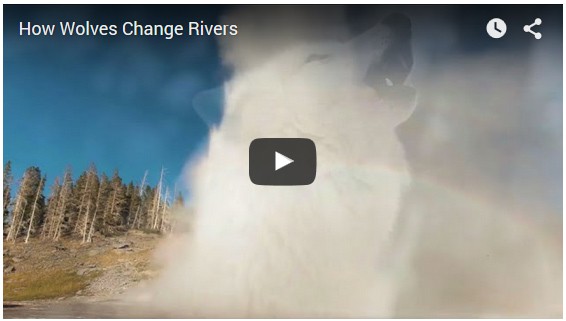by Mawer Investment Management, via The Art of Boring Blog
Grey and auburn fur flashed before the park rangers’ eyes, as the eight wolves bounded out of their cages and into the snowy drift of Yellowstone National Park. The animals were adolescents from Alberta’s Mackenzie Valley wolf population and had been tranquilized and carted over five hundred miles to be released into the park. They were among thirty-one wolves to be introduced into Yellowstone in January of 1995.
When the enclosures opened, the wolves took off running.
In 1926, the population of grey wolves in Yellowstone had all but disappeared. For decades, wolves had been hunted for sport or killed by ranchers as part of “predator control programs” which viewed them as threats to livestock and disruptive to the “ideal ecosystem.” Between 1883 and 1917, over one hundred thousand wolves had been killed for bounty in Montana and Wyoming alone. And by the 1970s, the American wolf had become an endangered species. When they were finally reintroduced into Yellowstone in 1995, wolves had been gone for over seventy years.
The re-introduction of wolves into Yellowstone came with unforeseen consequences. Although biologists had long suspected the negative impact of removing an apex predator from the ecosystem, they were unprepared for the degree of change that would follow. Reintroducing the wolves caused a trophic cascade, an ecological process that starts at the top of the food chain and tumbles all the way down to the bottom.
It transformed Yellowstone National Park.
The impact began with the elk. The return of the wolves drove the large elk population down and altered their feeding behavior. With the wolves on their tails, the elk now had to keep on the move, which meant that they couldn’t overgraze; flora within the valley now had an opportunity to regenerate, allowing other species to thrive. Trees quintupled in height only a few years after the wolves returned. Otters, beavers, birds, and rabbits flourished. The Grizzly bear population grew with more berries available. Even the geography changed; more trees and less soil erosion meant that river banks became more stable and in turn, they meandered less.
The destruction and then reintroduction of the wolves in Yellowstone serves as an important cautionary tale about our limited understanding of complex, adaptive systems. While humans often presume to understand how these systems function,
we rarely have more than a basic grasp of the intricate cobweb of relationships involved in them.
Assumptions on Causality
One of the core lessons from Yellowstone is that we need to be careful of the assumptions we make about causal relationships in complex systems. People hold an impressive number of assumptions in their heads about the relationship between things/people. Indeed, we need these beliefs in order to operate in our complex world. But it is important to remember that these assumptions are simply theories for how the world works. They are often wrong.
How can you start to identify these assumptions in practice? Usually, they can be recognized by their “if/then” nature:
If you drop a glass onto the floor, then the glass will break (because of gravity)
If you punch a stranger in the face, then they will sock you back (because they are mad)
If the Fed raises interest rates, then equities will pullback (because the discount rate used to evaluate equities will go up)
Proactively trying to recognize your assumptions is important because we often aren’t fully aware of the beliefs we hold, and yet faulty beliefs can quickly lead us astray. In the early twentieth century, the scientific community in the U.S. generally believed in an “ideal ecosystem” with few apex predators. They assumed that an ecosystem would be healthier with more desirable animals habituating it, such as deer, elk and caribou, and fewer undesirable predators. So a lot of wolves, coyotes and bears were killed. The net result was that prey often began to feed on vegetation unchecked, throwing their ecosystems off kilter.
Similarly, the investing community makes mistakes all the time related to causal relationships. Investors often assume that a causal relationship exists when it is in fact spurious, or they believe that a relationship that seems to hold true today will continue to do so in the future. For example, the following are theories that investors have historically held up as truths but which have recently been falsified:
- Bond and equity prices always move in opposite directions. The introduction of quantitative easing has shown that the correlation between bonds and equities does not have to be negative and can indeed be positive.
- Higher interest rates will attract more capital into a currency. In the last year, Brazil and Russia’s central banks have both raised interest rates and still watched as their currencies have fallen.
- GDP growth will translate into superior investment growth. For the first half of this year, China’s growth figures were absolutely abysmal – and yet stock returns were soaring (until they suddenly reversed). GDP growth does not always translate to investment returns in the short-term.
The Stock Market as Ecosystem
The ecosystem is an apt case study for the stock market for two reasons. First, both ecosystems and stock markets are what scientists refer to as complex, adaptive systems. They consist of a vast array of micro players that interact in interwoven, complex and evolving ways. This complexity means that outcomes can be very difficult to predict.
Second, biological ecosystems and stock markets are both arenas in which human presumption has the tendency to run wild. In both systems, people have historically overestimated their ability to predict and control outcomes. This was true in the case of the people who believed it was a good idea to kill off all the wolves in Yellowstone, just as it is true when an investor believes he knows exactly how markets will react if the Federal Reserve raises rates.
Yellowstone reminds us of the importance of intellectual humility in the face of complex, adaptive systems. We are usually much less aware of their intricacies than we think.
This post was originally published at Mawer Investment Management















